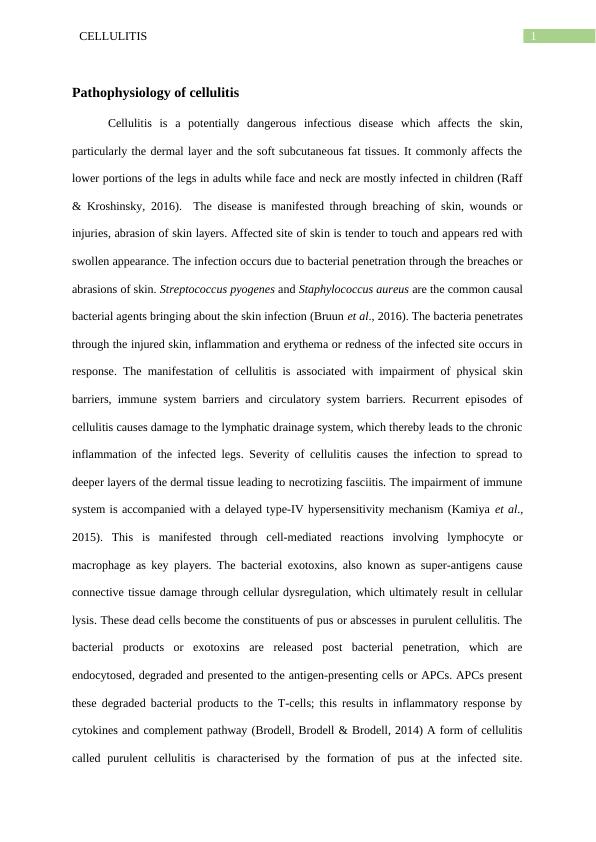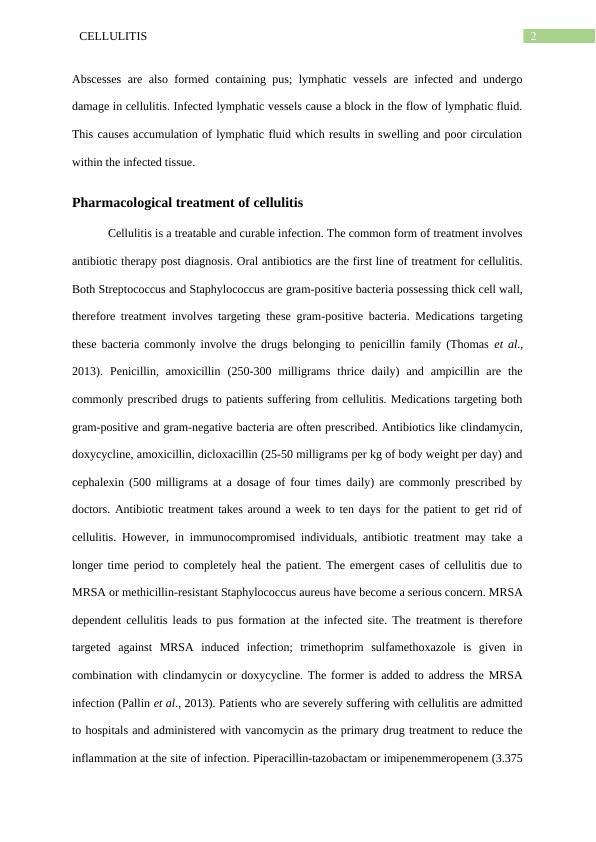Pathophysiology and Treatment of Cellulitis
7 Pages1683 Words83 Views
Added on 2023-04-21
About This Document
This document provides an overview of the pathophysiology of cellulitis, including the bacterial agents involved and the immune system response. It also discusses the pharmacological treatment options, including antibiotics, for cellulitis. Additionally, a care plan for managing cellulitis is outlined.
Pathophysiology and Treatment of Cellulitis
Added on 2023-04-21
ShareRelated Documents
Running head: CELLULITIS
Cellulitis
Name of student:
Name of university:
Author Note:
Cellulitis
Name of student:
Name of university:
Author Note:

1CELLULITIS
Pathophysiology of cellulitis
Cellulitis is a potentially dangerous infectious disease which affects the skin,
particularly the dermal layer and the soft subcutaneous fat tissues. It commonly affects the
lower portions of the legs in adults while face and neck are mostly infected in children (Raff
& Kroshinsky, 2016). The disease is manifested through breaching of skin, wounds or
injuries, abrasion of skin layers. Affected site of skin is tender to touch and appears red with
swollen appearance. The infection occurs due to bacterial penetration through the breaches or
abrasions of skin. Streptococcus pyogenes and Staphylococcus aureus are the common causal
bacterial agents bringing about the skin infection (Bruun et al., 2016). The bacteria penetrates
through the injured skin, inflammation and erythema or redness of the infected site occurs in
response. The manifestation of cellulitis is associated with impairment of physical skin
barriers, immune system barriers and circulatory system barriers. Recurrent episodes of
cellulitis causes damage to the lymphatic drainage system, which thereby leads to the chronic
inflammation of the infected legs. Severity of cellulitis causes the infection to spread to
deeper layers of the dermal tissue leading to necrotizing fasciitis. The impairment of immune
system is accompanied with a delayed type-IV hypersensitivity mechanism (Kamiya et al.,
2015). This is manifested through cell-mediated reactions involving lymphocyte or
macrophage as key players. The bacterial exotoxins, also known as super-antigens cause
connective tissue damage through cellular dysregulation, which ultimately result in cellular
lysis. These dead cells become the constituents of pus or abscesses in purulent cellulitis. The
bacterial products or exotoxins are released post bacterial penetration, which are
endocytosed, degraded and presented to the antigen-presenting cells or APCs. APCs present
these degraded bacterial products to the T-cells; this results in inflammatory response by
cytokines and complement pathway (Brodell, Brodell & Brodell, 2014) A form of cellulitis
called purulent cellulitis is characterised by the formation of pus at the infected site.
Pathophysiology of cellulitis
Cellulitis is a potentially dangerous infectious disease which affects the skin,
particularly the dermal layer and the soft subcutaneous fat tissues. It commonly affects the
lower portions of the legs in adults while face and neck are mostly infected in children (Raff
& Kroshinsky, 2016). The disease is manifested through breaching of skin, wounds or
injuries, abrasion of skin layers. Affected site of skin is tender to touch and appears red with
swollen appearance. The infection occurs due to bacterial penetration through the breaches or
abrasions of skin. Streptococcus pyogenes and Staphylococcus aureus are the common causal
bacterial agents bringing about the skin infection (Bruun et al., 2016). The bacteria penetrates
through the injured skin, inflammation and erythema or redness of the infected site occurs in
response. The manifestation of cellulitis is associated with impairment of physical skin
barriers, immune system barriers and circulatory system barriers. Recurrent episodes of
cellulitis causes damage to the lymphatic drainage system, which thereby leads to the chronic
inflammation of the infected legs. Severity of cellulitis causes the infection to spread to
deeper layers of the dermal tissue leading to necrotizing fasciitis. The impairment of immune
system is accompanied with a delayed type-IV hypersensitivity mechanism (Kamiya et al.,
2015). This is manifested through cell-mediated reactions involving lymphocyte or
macrophage as key players. The bacterial exotoxins, also known as super-antigens cause
connective tissue damage through cellular dysregulation, which ultimately result in cellular
lysis. These dead cells become the constituents of pus or abscesses in purulent cellulitis. The
bacterial products or exotoxins are released post bacterial penetration, which are
endocytosed, degraded and presented to the antigen-presenting cells or APCs. APCs present
these degraded bacterial products to the T-cells; this results in inflammatory response by
cytokines and complement pathway (Brodell, Brodell & Brodell, 2014) A form of cellulitis
called purulent cellulitis is characterised by the formation of pus at the infected site.

2CELLULITIS
Abscesses are also formed containing pus; lymphatic vessels are infected and undergo
damage in cellulitis. Infected lymphatic vessels cause a block in the flow of lymphatic fluid.
This causes accumulation of lymphatic fluid which results in swelling and poor circulation
within the infected tissue.
Pharmacological treatment of cellulitis
Cellulitis is a treatable and curable infection. The common form of treatment involves
antibiotic therapy post diagnosis. Oral antibiotics are the first line of treatment for cellulitis.
Both Streptococcus and Staphylococcus are gram-positive bacteria possessing thick cell wall,
therefore treatment involves targeting these gram-positive bacteria. Medications targeting
these bacteria commonly involve the drugs belonging to penicillin family (Thomas et al.,
2013). Penicillin, amoxicillin (250-300 milligrams thrice daily) and ampicillin are the
commonly prescribed drugs to patients suffering from cellulitis. Medications targeting both
gram-positive and gram-negative bacteria are often prescribed. Antibiotics like clindamycin,
doxycycline, amoxicillin, dicloxacillin (25-50 milligrams per kg of body weight per day) and
cephalexin (500 milligrams at a dosage of four times daily) are commonly prescribed by
doctors. Antibiotic treatment takes around a week to ten days for the patient to get rid of
cellulitis. However, in immunocompromised individuals, antibiotic treatment may take a
longer time period to completely heal the patient. The emergent cases of cellulitis due to
MRSA or methicillin-resistant Staphylococcus aureus have become a serious concern. MRSA
dependent cellulitis leads to pus formation at the infected site. The treatment is therefore
targeted against MRSA induced infection; trimethoprim sulfamethoxazole is given in
combination with clindamycin or doxycycline. The former is added to address the MRSA
infection (Pallin et al., 2013). Patients who are severely suffering with cellulitis are admitted
to hospitals and administered with vancomycin as the primary drug treatment to reduce the
inflammation at the site of infection. Piperacillin-tazobactam or imipenemmeropenem (3.375
Abscesses are also formed containing pus; lymphatic vessels are infected and undergo
damage in cellulitis. Infected lymphatic vessels cause a block in the flow of lymphatic fluid.
This causes accumulation of lymphatic fluid which results in swelling and poor circulation
within the infected tissue.
Pharmacological treatment of cellulitis
Cellulitis is a treatable and curable infection. The common form of treatment involves
antibiotic therapy post diagnosis. Oral antibiotics are the first line of treatment for cellulitis.
Both Streptococcus and Staphylococcus are gram-positive bacteria possessing thick cell wall,
therefore treatment involves targeting these gram-positive bacteria. Medications targeting
these bacteria commonly involve the drugs belonging to penicillin family (Thomas et al.,
2013). Penicillin, amoxicillin (250-300 milligrams thrice daily) and ampicillin are the
commonly prescribed drugs to patients suffering from cellulitis. Medications targeting both
gram-positive and gram-negative bacteria are often prescribed. Antibiotics like clindamycin,
doxycycline, amoxicillin, dicloxacillin (25-50 milligrams per kg of body weight per day) and
cephalexin (500 milligrams at a dosage of four times daily) are commonly prescribed by
doctors. Antibiotic treatment takes around a week to ten days for the patient to get rid of
cellulitis. However, in immunocompromised individuals, antibiotic treatment may take a
longer time period to completely heal the patient. The emergent cases of cellulitis due to
MRSA or methicillin-resistant Staphylococcus aureus have become a serious concern. MRSA
dependent cellulitis leads to pus formation at the infected site. The treatment is therefore
targeted against MRSA induced infection; trimethoprim sulfamethoxazole is given in
combination with clindamycin or doxycycline. The former is added to address the MRSA
infection (Pallin et al., 2013). Patients who are severely suffering with cellulitis are admitted
to hospitals and administered with vancomycin as the primary drug treatment to reduce the
inflammation at the site of infection. Piperacillin-tazobactam or imipenemmeropenem (3.375

End of preview
Want to access all the pages? Upload your documents or become a member.
